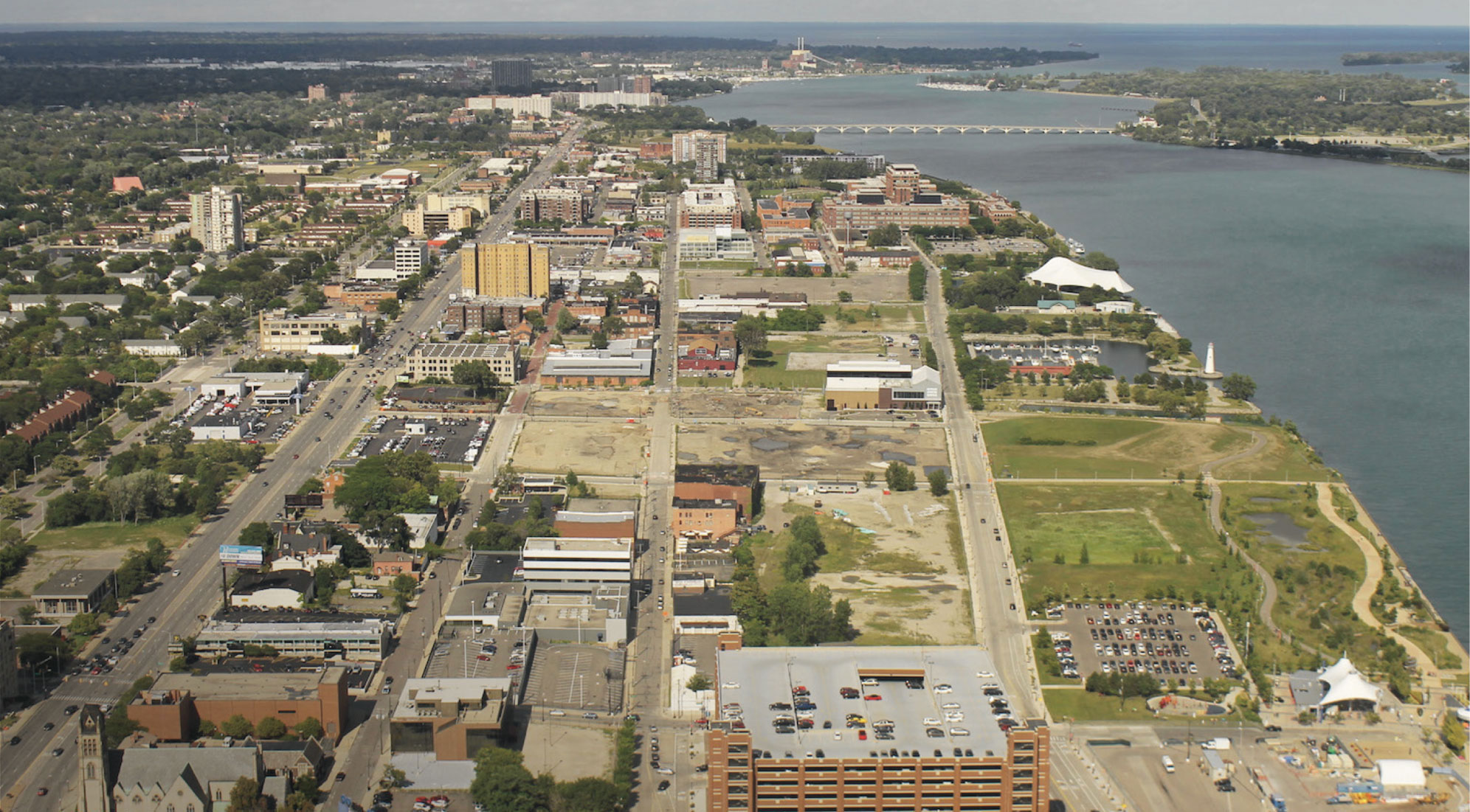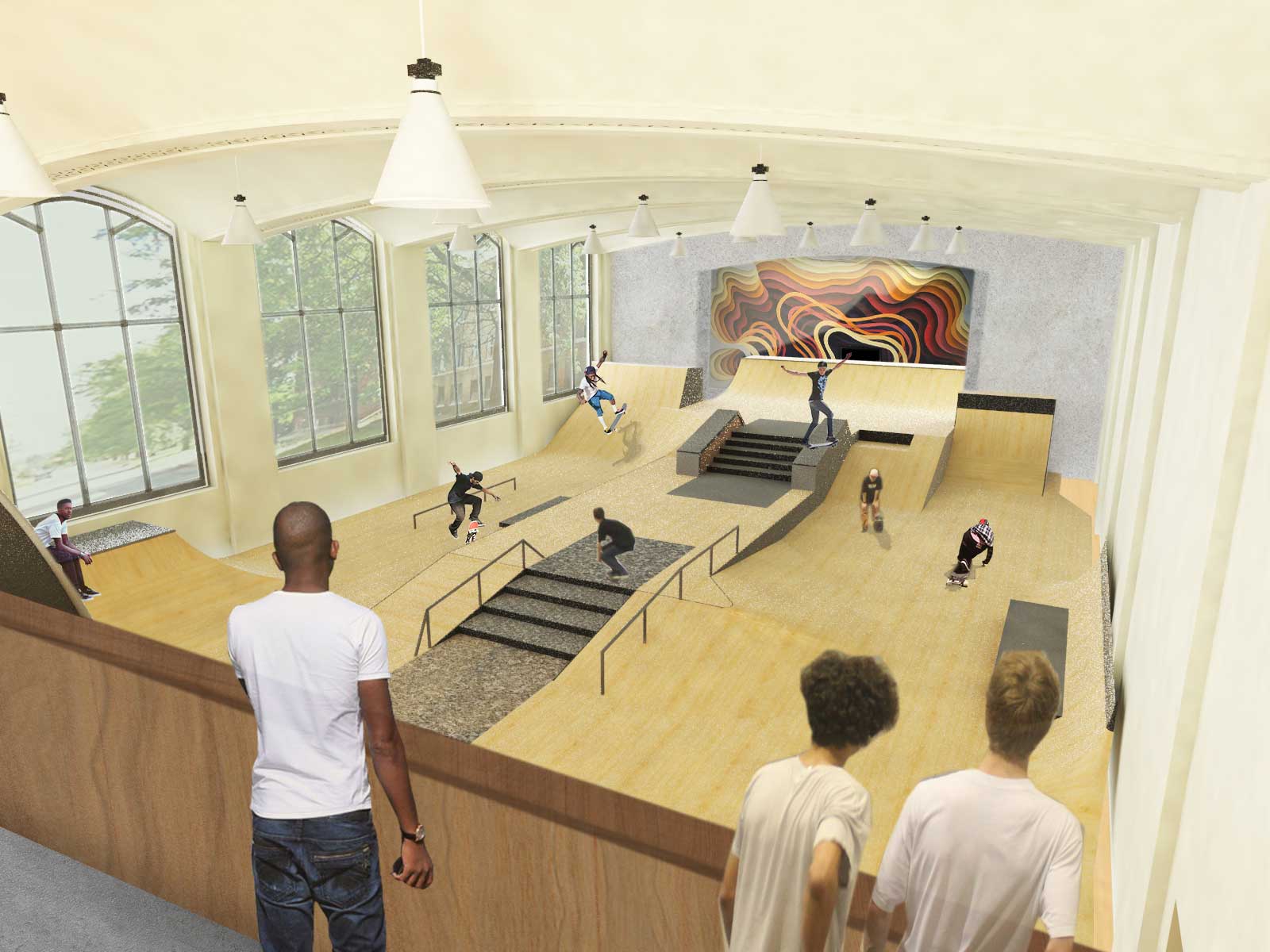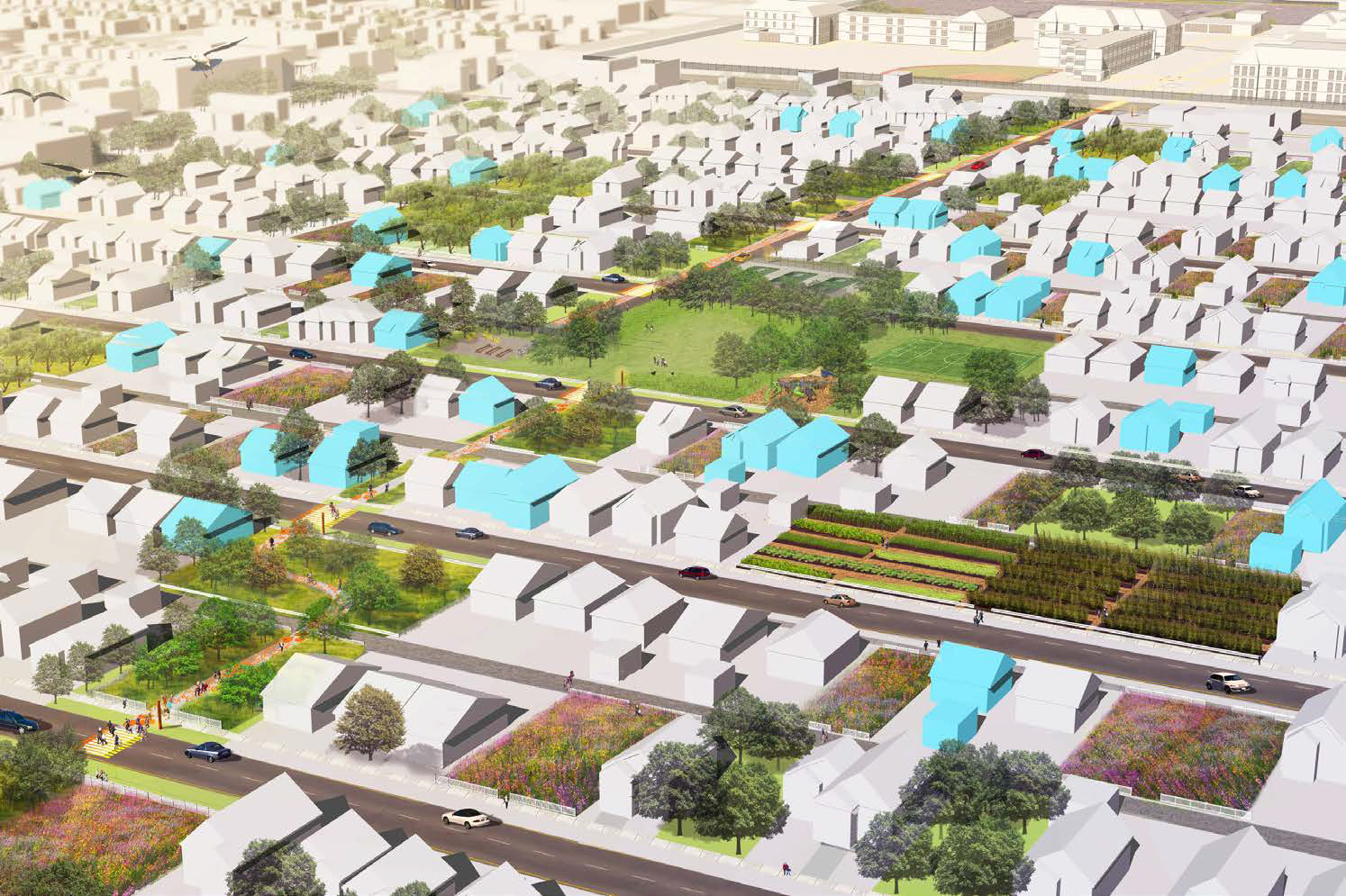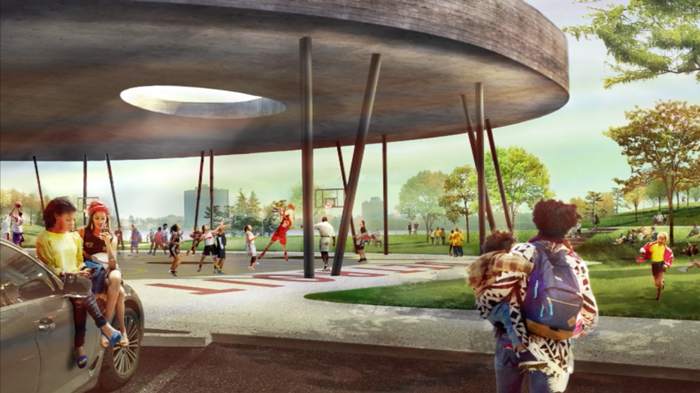
We are celebrating 15 years — and counting — of stories that are deeply researched and deeply felt, that build a historical record of what the city has been.
We are celebrating 15 years — and counting — of stories that are deeply researched and deeply felt, that build a historical record of what the city has been.
Maurice Cox grew up in Brooklyn, a borough whose name has since become a global shorthand for gentrification. An urban designer, architectural educator, and former mayor of the City of Charlottesville, VA, in 2015 Cox became head of the planning department of Detroit, where he hopes to prevent the forces that have reshaped his childhood home from taking over the Motor City. The city’s population peaked at 1.8 million, but has less than half as many residents today; Cox is using design to catalyze growth that’s incremental and closely in line with the city’s strong sense of self. This means making the most of an abundance of vacant land and listening closely to what residents have to say. Below, Cox speaks with Marc Norman about plans and projects underway, preserving Black spaces, and how Detroit might serve as a model for other cities in the 21st century.
New York lost almost a million people in the 20th century. It triggered talk of planned shrinkage. But that wasn’t pursued, and by 2001 the city was planning for a million additional residents by 2030. Are there any lessons from this experience that you might take away for Detroit?
I never bought into the notion that cities shrink. I find that to be an incredibly pessimistic view of the evolution of cities. Cities don’t shrink; their populations do. And just as populations decline, populations also grow again. What stays consistent is a city’s responsibility to steward the land and preserve all assets until the population begins to grow again.
Detroit still has capacity for a population of 1.8 million, and we’re at less than 700,000. So part of our challenge is, how to prevent buildings turning into blight, to the point of having to demolish them?
On the other hand, if it does make sense to tear some things down, what do we put in their place? The architect’s mindset is often that the only thing that can replace a structure is another structure. But in Detroit, that makes no sense financially; it makes no sense in terms of the population. So we have to turn to other disciplines for an answer.
That’s where landscape architecture is key. When your population shrinks you inherit land, and you have to figure out what to do with that.
You lived in Italy for many years. Between the second and the sixth century, Rome went from around a million people to 30,000. Have you learned any lessons from Italian history that you might apply to Detroit?
I haven’t studied that history in depth, but there are obvious parallels. There was a lot of creative adaptive reuse in Rome, and a lot of scavenging. And today we would call Piranesi’s etchings of imaginary and remaining structures ruin porn.
In Detroit, that narrative of fetishizing our vacant property is starting to wane, because there’s a counter-narrative that’s much more about the future. Camilo José Vergara, a photographer who documents buildings over time, once observed that Detroit had the finest collection of empty mid-rise to high-rise buildings around Grand Circus Park. He proposed that we keep them empty and make the park into a kind of museum. But today, every one of those buildings is under renovation.
We’ve coined a term: tactical preservation. The idea is, if you can’t occupy 100 percent of a historic asset, could you occupy two percent, or five percent? What would it take for the financial institutions, the permitting institutions, and the insuring institutions to allow incremental occupation of a larger asset so that it doesn’t fall into ruin?
In fact, we’re inviting the Urban Land Institute to do a weeklong investigation into this concept, looking at churches, libraries, bank buildings, schools, recreation centers, and small industrial buildings. They’re trying to help us conceive of how this strategy might work. How do you go to a bank and get a $200,000 construction loan on a $2 million asset? How do you go through the city’s permitting process to allow for the insertion of a community theater within the auditorium of a 200,000 square foot school? How do you not force them to sprinkler the whole building just so to occupy a portion? How do you get insurance?
You’ve talked about Detroit being a 21st-century city. Can you give some insight into that thinking, and into how planners can shape that 21st-century city?
I specifically refer to it as a 21st-century city as opposed to a legacy city. I’ve often tried to figure out, how is a city like Detroit positioned for the 21st century? What’s our competitive advantage? If you think about vacant land as an asset and not a detriment, Detroit probably has the largest open land resource of any American city under a single authority: around 24 square miles. If anyone is going to reinvent the 21st-century city, it’s going to be a city that can exercise control over the destiny of land.
For the record, that’s half of San Francisco.
And it’s the size of Manhattan. Of course, it’s not a contiguous island; it’s not a Central Park. It’s this speckled mosaic of mostly formerly residential properties that are threaded throughout established neighborhoods. It’s a unique challenge.
It lends itself to an incremental approach to planning. With formerly residential lots, you don’t get to do the 160-acre intervention that requires commensurate capital and development. It’s more surgical, more scaled to the community — which lends itself to the smaller-scale developer. That’s the hope.
At the same time, we have an opportunity to transfer and dispose of land at a scale that very few cities in America can. We can turn over 20 or 40 acres in a neighborhood to a single developer. The Fitzgerald Revitalization Project involves 400 lots being transferred to a group of young entrepreneurs.
I have never seen a plan the likes of Fitzgerald. It pairs housing revitalization with neighborhood regeneration and productive landscapes to create economic opportunity. Does this play into the notion of “smooth growth” I’ve heard you discuss?
I’m fascinated by this idea of smooth growth. It’s a Black theorist, Marshall Brown, who thought of this. He basically said, “Is the only model we have a growth model? What do we do with the typical African American neighborhoods that have a zero-growth context? If the only thing we have to offer them is Congress for the New Urbanism-style infill development, then we have nothing to offer them.”
I was intrigued by this idea during my first months here. I was looking for theories that would apply to Detroit, because everything I was seeing was in Boston, San Francisco, New York, and they were all humming — whereas I was spending my days going to these areas in Detroit where nothing was happening. And yet there was land.
So my first hire was a landscape architect, Alexa Bush. She had done her Master’s thesis on activating vacant land. She was talking about grassroots self-determination: people finding alternative uses for vacant land in their neighborhoods. I saw the opportunity to go to scale. I said, “What if we could create a neighborhood where someone could walk a quarter-square mile and not see blight? What if every lot was designed and every house was occupied — and we didn’t build anything new?”
We started to work with Spackman Mossop Michaels on this theme of planting gardens on every vacant lot in the neighborhood. How could we have low-maintenance gardens and highly productive gardens? Could that in and of itself be a building strategy?
In the neighborhood there were 600 households, and 120 houses, and almost as many vacant lots. We said, what if we paired the economics of the vacant lot strategy with housing renovations? We would prepare a design for vacant land, cost it out per lot, and put it into the framework so that a developer who’s responding to the housing could also calculate the vacant land strategy and its maintenance.
When we presented this to the mayor, he said, “What idiot in their right mind is going to take on 20 acres of vacant land?” Because housing developers do housing. We had a team in housing redevelopment run the numbers, and they were able to show how it could be done.
We got a handful of proposals, and one was from these young, ambitious African American developers who had moved to Detroit two years earlier. In fact, I met David Alade my second week here. He said, “Hey, I’ve been buying up houses in areas and renovating them. I’d love to show you what we do.” I jumped in a car with him and his partner Andrew Colom a week later and they took me to Atkinson Street, where they had purchased ten houses on the same block and were really beautifully bringing them back.
Now they’re doing the largest, most ambitious neighborhood housing stabilization plan in the city. To the Mayor’s point, who is crazy enough to do this work? It speaks to the developer who’s looking for social impact. And it is not by chance that these particular developers are African American.
So, it’s a Black city. We’re talking about African Americans, we’re talking about entrepreneurship and cultural authenticity. You’ve worked and lived in lots of places with African American cultural authenticity: New York, Charlottesville, New Orleans, and Detroit. What’s a way to celebrate that authenticity without fetishizing it or coopting it, while also creating opportunities for cultural producers or inheritors?
It is fascinating. Even as the country was looking at the decline of this once-great American city, the people here remained fiercely proud. They’ve stuck it out; they’ve kept up their homes, their institutions. There might have been a political crisis in Detroit, there might have been an economic crisis, but there was certainly no identity crisis.
So people can articulate the culture that they’ve preserved really well. I’ve found this in other communities where I’ve worked. Everybody on the outside thinks there’s something desperately wrong with the community, and it simply doesn’t mirror the lived reality of residents. I’ve often wondered, how do you tap into that? How do you tap into Black culture?
I’ll use the park in Fitzgerald as a case in point. This was really just a collection of vacant, formerly residential parcels that were aggregated at the center of the neighborhood. The community said, “We would love to have a neighborhood park.” There were a lot of questions about what the park would convey. Would it convey something aspirational? Is it just a park?
The name Ella Fitzgerald Park came out of a community meeting. There used to be an elementary school in the neighborhood called Ella Fitzgerald Elementary, so the community wanted to transfer that memory to the park.
There was a suggestion that an African American artist here do a ceramic mural in the park, and he chose the theme of local youth.
Then people were like, “We can’t name the park Ella Fitzgerald if there’s no music.” So the landscape architects interpreted sheet music of the song “Dream a Little Dream of Me” onto the supergraphics for the street.
I don’t think that a designer could have dreamt all that up. Black culture is often a collage; it’s often fragments that are pulled together. And it has deep and subtle meanings to those who know how to read it.
Now, will that stop gentrification happening? No. But if you come into this neighborhood, somebody’s going to tell you the story of that park.
In Oakland, another great Black city, cops were called on Black families barbecuing. People come into Black spaces and see people as other for things that are completely legal, and that are actually about joy. As these places change, how can newcomers honor the existing culture? And can planners and architects have a hand in this?
It reminds me of New Orleans. There’s a neighborhood that has always been an African American artistic enclave, and second lines traditionally came through, so you have marching bands playing down the middle of the street. But when it started to be gentrified and white people started buying these beautiful little cottages, it didn’t take long before they started complaining about the people playing music in the street.
Wow. In New Orleans.
There’s a cultural specificity to the way people gather. How do you build it into the DNA of the places we make as a way to say, “We celebrate this activity”?
In Michael Van Valkenburgh and David Adjaye’s West Riverfront Park, they made basketball one of the first things you see. They created a social space for it. It’s under a big floating canopy, as if to say, “You are welcome.”
It’s not unlike the pickup basketball courts in Cadillac Square. Historically, the downtown business district is not a place where guys are expected to play pickup basketball. But it means a lot to folks who come from the neighborhoods that activities they might engage in are socially accepted, and actually embraced.
I’ve asked myself, is there such thing as Black space? Is there? And I think these are examples of Black cultural expression.
And if architects and planners don’t understand that cultural specificity, they can overlay things that inadvertently exclude people.
There are interesting conversations about how you create a social mixer in public space in Detroit. Usually planners are like, “How do I make Black people who don’t feel like they belong here comfortable?” But what happens when Black folks are the majority? It’s like, “Well, how do we make white people feel comfortable in our space?”
In April, I walked along the waterfront on what seemed to be the first great spring day, and it was a Black space full of Black joy and Black energy, Black magic. It was full of flaneurs, but also bike riding and flirting and everything else. How do you keep that magic and joy as you think about redeveloping the waterfront?
I was fascinated by the East Riverfront planning process. It was the first time we held interviews to choose the consultant team in public. When I suggested it, people thought I was crazy. But we did it, and about 200 people showed up and stayed the entire day. People were saying it was a master class on what Detroit could be. We gained trust that this was not some shady backroom deal.
Then people started asking, “What good is having a great riverfront if the people who live closest to the riverfront can’t get to it?” A number of people live north of this seven-lane boulevard that separates them from the riverfront — there are townhouses and apartment buildings, and Section 8 housing as well.
So the conversation changed. And guess what: The first multimillion-dollar investment there will connect those neighborhoods to the riverfront. Even I didn’t anticipate that that would be the first and most important investment.
What drove that decision? Was it community input?
In this case, residents talked about how difficult it was to access the river. They have to cross this highway that’s poorly marked, and the off-road access points are largely derelict.
People find clues that they’re welcome or not welcome. We could’ve invested millions of dollars in the riverfront and not have done a thing about the highway, and the people who live north of it would have got the message, “You are not welcome in this park.”
My time in public office taught me how to listen. On a city council, where you have the public comment every week, you listen to people who really, really care about their city. They may not have the right words; their tone may sound angry; but underneath there’s something there. You just find these incredible insights — and that’s the stuff that makes for an inclusive city.
You lived in New York not long after the fiscal crisis, and in Charlottesville as it considered a change in its jurisdiction from city to town, and then in New Orleans after Katrina. And now you’re in post-bankruptcy Detroit.
I tend to run towards the fire. When a city is in a crisis moment, there’s a willingness to consider unconventional alternatives.
I feel like I came to Detroit at the right time. They had just gotten out of bankruptcy. They had had a citywide conversation about what the future of the city might be if the population continued to shrink.
What they didn’t do is say, “Well, what if we grow?” And that was the directive that the mayor gave me when I got here. He says, “I want to grow the population.” He was literally quizzing me: “Do you believe in growth? Do you believe in economic development?” And I was like, “Hell, yeah.”
You need a context for innovation. It often happens when it’s clear that the same strategies you’ve always used won’t work anymore. And that’s where Detroit is. My thought was, if I could get some of the leading minds in urban thinking operating in this city we would find some new answers, and those answers would have broad application to other cities.
Today, a lot of designers, architects, landscape architects are coming into the city in a way they haven’t before. Do you see your role as defining a style or movement for this moment in Detroit?
I think of access to a socially, environmentally healthy environment as a kind of birthright. It’s always puzzling to me why design hasn’t been readily accessible to Black communities.
I’ve always thought that if we could hold onto Detroit’s incredible legacy of great architecture — if we could repurpose it, and give it a new civic presence — we would send a signal about the value of the public realm. We have this incredible tradition of cutting-edge design, whether from the boom in the ’20s or in the ’50s with Isamu Noguchi and Mies van der Rohe. So this is not something that came from another planet.
My interest in this also comes from a fear that after decades of dormancy in Detroit’s neighborhoods, the push to develop was going to unleash a slew of really bad architecture. Part of my thinking was, how do we start a conversation about the value of design, and emphasize that these historic neighborhoods deserve the best design?
Can you say more about what Detroiters have taught you about the city?
There are people in Detroit who have been in their house for 60 years. As a planner coming into their neighborhood, I have no doubt who is the expert. Also, maybe because of the socioeconomic cross-section here, the people are incredibly creative, they’re wise. It defies the stereotype of a Black community. A lot of the narrative’s like, “Oh, Detroit, has one of the highest poverty rates in the country.” All right, let’s say it’s 35 percent. But what about the other 65 percent? Who are those people? They’re middle-class people, they’re working-class people, they’re professionals.
We’re working with a fundamentally healthy community that has dealt with a whole series of harsh economic and social challenges, but as a result they’ve built up a level of resiliency that makes it really energizing to engage them.
You’re articulating a public interest design ethos which I usually attribute to organizations fighting the city. To see it embedded in the city government is amazing — and probably should be the goal.
This is what I’ve always wanted to do. But even as somebody who has a vivid imagination, I never assumed that I would be able to do it at this scale.
But we don’t have forever to do this. We’re at a tipping point. Detroit could go the way of Washington, New Orleans, New York — places that are unrecognizable from 20 years ago. In the future, people are either going to say, “Wow, they didn’t really understand the forces that they were unleashing” — or, “They figured it out, and they got ahead of the curve.”
The city is still affordable. We own a third of all of the land, so we’re not just selling it to the highest bidder. We are going to very consciously figure out what we want to dispose of and what we want to keep for the public interest.
Those kinds of strategic decisions give me hope that we can create this inclusive recovery story. And if we do, people are going to be studying it for many years to come.
The views expressed here are those of the authors only and do not reflect the position of The Architectural League of New York.



